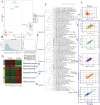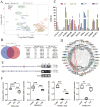mRNA-Seq of testis and liver tissues reveals a testis-specific gene and alternative splicing associated with hybrid male sterility in dzo
- PMID: 38551023
- PMCID: PMC11135213
- DOI: 10.1093/jas/skae091
mRNA-Seq of testis and liver tissues reveals a testis-specific gene and alternative splicing associated with hybrid male sterility in dzo
Abstract
Alternative splicing (AS) plays an important role in the co-transcription and post-transcriptional regulation of gene expression during mammalian spermatogenesis. The dzo is the male F1 offspring of an interspecific hybrid between a domestic bull (Bos taurus ♂) and a yak (Bos grunniens ♀) which exhibits male sterility. This study aimed to identify the testis-specific genes and AS associated with hybrid male sterility in dzo. The iDEP90 program and rMATS software were used to identify the differentially expressed genes (DEG) and differential alternative splicing genes (DSG) based on RNA-seq data from the liver (n = 9) and testis (n = 6) tissues of domestic cattle, yak, and dzo. Splicing factors (SF) were obtained from the AmiGO2 and the NCBI databases, and Pearson correlation analysis was performed on the differentially expressed SFs and DSGs. We focused on the testis-specific DEGs and DSGs between dzo and cattle and yak. Among the top 3,000 genes with the most significant variations between these 15 samples, a large number of genes showed testis-specific expression involved with spermatogenesis. Cluster analysis showed that the expression levels of these testis-specific genes were dysregulated during mitosis with a burst downregulation during the pachynema spermatocyte stage. The occurrence of AS events in the testis was about 2.5 fold greater than in the liver, with exon skipping being the major AS event (81.89% to 82.73%). A total of 74 DSGs were specifically expressed in the testis and were significantly enriched during meiosis I, synapsis, and in the piRNA biosynthesis pathways. Notably, STAG3 and DDX4 were of the exon skipping type, and DMC1 was a mutually exclusive exon. A total of 36 SFs were significantly different in dzo testis, compared with cattle and yak. DDX4, SUGP1, and EFTUD2 were potential SFs leading to abnormal AS of testis-specific genes in dzo. These results show that AS of testis-specific genes can affect synapsis and the piRNA biosynthetic processes in dzo, which may be important factors associated with hybrid male sterility in dzo.
Keywords: alternative splicing; dzo; male sterility; splicing factor.
Plain language summary
The interspecific hybrid offspring of a domestic bull (Bos taurus) and a yak (Bos grunniens) display heterosis in meat and milk production. The hybrid offspring are particularly adaptable to the harsh environments of the Qinghai-Tibet Plateau. However, the male F1 to F3 offspring of this interspecies hybrid are infertile, and spermatogenesis is arrested at meiosis preventing the prolonged utilization of the benefits of heterosis. This study aimed to identify the testis-specific genes and alternative splicing (AS) associated with hybrid male sterility using RNA-Seq data from the liver and testis tissues of domestic cattle, yaks, and their F1 offspring (dzo). The expression of the testis-specific genes became disordered during mitosis and meiosis in dzo. Their testis-specific genes with AS events were enriched during synapsis and in the piRNA biosynthetic processes. In addition, we identified the potential splicing factors associated with abnormal testis-specific AS gene expression in dzo. These results reveal the important role of AS in the meiotic arrest of dzo.
© The Author(s) 2024. Published by Oxford University Press on behalf of the American Society of Animal Science. All rights reserved. For commercial re-use, please contact reprints@oup.com for reprints and translation rights for reprints. All other permissions can be obtained through our RightsLink service via the Permissions link on the article page on our site—for further information please contact journals.permissions@oup.com.
Conflict of interest statement
Authors have no conflicts of interest.
Figures



Similar articles
-
[Progress on meiotic gene expression and epigenetic regulation of male sterility in Dzo cattle].Yi Chuan. 2020 Nov 20;42(11):1081-1092. doi: 10.16288/j.yczz.20-176. Yi Chuan. 2020. PMID: 33229315 Review. Chinese.
-
N6-methyladenosine RNA demethylase ALKBH5 is testis-specifically downregulated in hybrid male sterile dzo and is a target gene of bta-miR-200a.Theriogenology. 2022 Jul 15;187:51-57. doi: 10.1016/j.theriogenology.2022.04.022. Epub 2022 Apr 27. Theriogenology. 2022. PMID: 35504087
-
Promoter hypermethylation of PIWI/piRNA pathway genes associated with diminished pachytene piRNA production in bovine hybrid male sterility.Epigenetics. 2020 Sep;15(9):914-931. doi: 10.1080/15592294.2020.1738026. Epub 2020 Mar 6. Epigenetics. 2020. PMID: 32141383 Free PMC article.
-
Comparison of Y-chromosome-linked TSPY, TSPY2, and PRAMEY genes in Taurus cattle, yaks, and interspecific hybrid bulls.J Dairy Sci. 2019 Jul;102(7):6263-6275. doi: 10.3168/jds.2018-15680. Epub 2019 May 15. J Dairy Sci. 2019. PMID: 31103297
-
Male hybrid sterility in the cattle-yak and other bovines: a review.Biol Reprod. 2021 Mar 11;104(3):495-507. doi: 10.1093/biolre/ioaa207. Biol Reprod. 2021. PMID: 33185248 Review.
Cited by
-
Comprehensive analysis of long non-coding RNA and mRNA expression patterns during seminiferous tubules maturation in Guanzhong dairy goats.BMC Genomics. 2025 Feb 18;26(1):159. doi: 10.1186/s12864-025-11320-7. BMC Genomics. 2025. PMID: 39966702 Free PMC article.
References
-
- Cesari, E., M. Loiarro, C. Naro, M. Pieraccioli, D. Farini, L. Pellegrini, V. Pagliarini, P. Bielli, and C. Sette. 2020. Combinatorial control of Spo11 alternative splicing by modulation of RNA polymerase II dynamics and splicing factor recruitment during meiosis. Cell Death Dis. 11:240. doi:10.1038/s41419-020-2443-y - DOI - PMC - PubMed
MeSH terms
Substances
LinkOut - more resources
Full Text Sources
Medical
Research Materials
Miscellaneous

